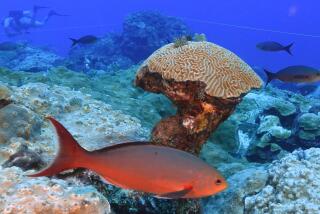Underwater Intimacy
- Share via
If marine biologist Sandy Brick could just create the right ambience, her coral might get in the mood to procreate. As it is, the reef-forming creatures at the Aquarium of the Pacific are not only cold fish in the propagation department but a real chore to baby-sit. “You have to have a really balanced system with the proper amount of light, calcium, water movement and helpful bacteria,” she says.
Coral are so fussy that the wildly popular Long Beach aquarium mostly uses fakes--made by a Tucson company that also creates faux kelp and mussels. One exception is the small “Live Coral Exhibit,” where Brick nurtures a fragile kaleidoscope of vivid oranges, blues and yellows.
With the world’s great reefs in declining health because of pollution and coastal development, aquarists hate to dip into the wild. So Brick and her peers at other aquariums swap coral fragments for asexual reproduction of the more common species. But some varieties native to the Great Barrier Reef will only release their foaming mass of eggs and sperm when the moon is full. “We’ve never been able to fabricate that activity” at the new aquarium, says Brick, 35, who came to Southern California after graduate school and a stint as curator at Coral World in the Virgin Islands. “But they’ve come out with lightbulbs that simulate moonlight, so we’re hoping.”
More to Read
Sign up for The Wild
We’ll help you find the best places to hike, bike and run, as well as the perfect silent spots for meditation and yoga.
You may occasionally receive promotional content from the Los Angeles Times.






